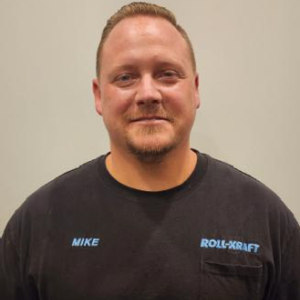Subscribe To Roll-Kraft
Receive the latest news from Roll-Kraft.

by Robert Sladky, VP of Tube Mill Engineering and Bret Molnar, Senior Technical Performance Specialist, Roll-Kraft Ohio, U.S.A.
In order for roll tooling to function properly, it’s necessary to ensure that your tooling and mill are free of excess grease, oil, dirt and other substances that can affect performance. In this article, we will provide some cleaning do’s and don’ts, along with some standard cleaning procedures.
Cleaning the Tooling
At Roll-Kraft, we recommend using cleaning tanks that are serviced by companies such as Safety-Kleen to remove grease, oil, dirt and other contaminants from the rolls as they come in. There are even higher-end cleaning processes, such as ultrasonic cleaning and hot water detergent pressure washers (similar to large and powerful dishwashers) that can get the job done as well.
To begin, the tooling is normally wiped down dry with rags so that it is not slippery. Many of our customers will polish their tooling to remove pick-up. While there is some benefit to this, care absolutely must be taken not to damage the rolls. No matter how skilled you are at polishing, or how carefully you remove material when you polish, any cleaning of the tooling will wear down that tooling to some degree. In this regard, cleaning is a bit of an art. Do not use materials such as aggressive sandpaper to polish the tooling; your tooling may look spectacular as a result, but it’s likely you’ll ruin the roll in the process by changing the contour and flaring it out. We’ll say it again: Cleaning must be done carefully.
For polishing purposes, you can use a Scotch-Brite pad – Scotch Brite will not score the surface of the hardened roll tooling, but it will successfully remove the light pick-up that can be found on the roll tooling. There are times when there is heavier pick-up on the tooling. In these cases, we recommend using nothing more aggressive than 150 grit emery cloth. If you can remove that pick-up using a finer grit such as 240, that really is best. In fact, that’s what we use to finish the rolls here at Roll-Kraft. If you use a more aggressive emery cloth, then you will probably create scratches that will only lead to more pick-up.
VERY IMPORTANT: Do not attempt to clean tooling while the mill is running. Tooling should only be cleaned when it is removed from the mill for a change-over.
Cleaning the Machine – Acceptable Procedures and Cleaners
If you utilize mills that run coolant on their tooling, you can hook up a pressure washer to the coolant lines and use that to clean the tooling/mill as it is running. Using coolant from the mill does not add any water to the coolant system so as to dilute it.
For mills that run dry with no coolant (like most roll formers do), we recommend simple common sense when wiping down excessive grease that may ooze out of the bearing blocks. To that end, we recommend using cleaners such as Simple Green to clean the rest of the mill components when the mill is down and not running. Simple Green will cut the grease; it’s environmentally friendly; and it’s available at many retail stores. Additionally, for those mills that incorporate coolant, it won’t upset the chemical balance of the concentration. Fresh water is fine, but it won’t do much to cut the grease on the mill. And, if you use just water, it will likely dilute the concentration of the coolant. We do not recommend using petroleum solvents, as they are not environmentally friendly. While petroleum solvents may cut grease effectively, they will contaminate and upset the chemical balance of the coolant.
In situations where you get flaking of material, paint or other substances from the product line as it is being formed, it can be cleaned using an industrial vacuum after the mill is shut down.
Basic Polishing Procedures
Below are some basic polishing procedures we recommend, along with accompanying photos.
.jpg)
Properly line up the roll on the machine.
.jpg)
This picture shows pick-up on the roll.
.jpg)
Use emery cloth - 150 grit, and wrap it around a back-up bar.
.jpg)
Polish the roll with even strokes, back and forth on the contour, with 150 grit to remove the pick-up.
.jpg)
Use emery cloth - 240 grit, and wrap it around a back-up bar.
.jpg)
Polish the roll with even strokes, back and forth on the contour, with 240 grit to remove any scratches.
.jpg)
Add very little oil to the rag.
.jpg)
Very slowly polish the roll with even strokes back and forth to bring out the luster.
.jpg)
Finished polished roll.
Looking for answers 24/7?
Click here to email any question you may have about roll tool cleaning procedures, tube mill, pipe mill or roll forming mill operations. One of our technicians will email you an answer or call you for more details.
Simply contact us here or call and get answers 24/7.
Contact Us (888) 953-9400
Roll-Kraft is pleased to announce the appointment of Mr. Mike Samplak to the position of Plant Manager at its headquarters facility in Mentor, OH.

Roll-Kraft is pleased to announce the appointment of Frank Lowery to Vice President of Roll Form Applications.

Roll-Kraft is pleased to announce the appointment of Kevin Gehrisch to the position of President.